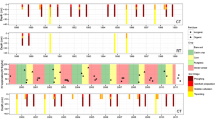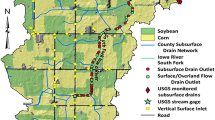Abstract
Nutrient losses from agricultural lands are responsible for degrading water quality and accelerating eutrophication at local and regional scale. Subsurface tile drainage is an agricultural water management measure extensively used in some Northwestern European countries to improve poor internal field drainage and crop production. However, drains constitute artificial and direct conduits responsible for shortening the residence time and accelerating nutrient transport through the hydrological system. Thus, they put the aquatic ecosystems at risk since they promote rapid drainage water transport and reduce the possibility for natural nutrient removal.
Edge-of-field technologies have been developed and implemented in the last decades to reduce diffuse pollution caused by nitrogen (N) and phosphorus (P) losses. These technologies are primarily used in critical source areas, where measures at farm-scale appear insufficient to meet the removal targets. They are placed at the edge of agricultural fields and connected to the main drainage pipe. Widely recognized technologies include constructed wetlands, woodchips bioreactors, and filter systems. This chapter presents the results obtained in Denmark from three different and currently investigated edge-of-field technologies treating agricultural drainage water.
Access this chapter
Tax calculation will be finalised at checkout
Purchases are for personal use only
Similar content being viewed by others
References
OSPAR Commission (2000) Quality status report 2000, region II – greater North Sea. OSPAR Commission, London
Snoeijs P, Andrén E (2017) Why is the Baltic Sea so special to live in? In: Snoeijs-Leijonmalm P, Schubert H, Radziejewska T (eds) Biological oceanography of the Baltic Sea. Springer, Dordrecht, pp 23–84. https://doi.org/10.1007/978-94-007-0668-2_2
European Environmental Agency (2018) European waters – assessment of status and pressures 2018. EEA, Luxembourg
Strock JS, Kleinman PJA, King KW, Delgado JA (2010) Drainage water management for water quality protection. J Soil Water Conserv 65:131A–136A
Goudie AS (2000) The human impact on the natural environment.5th edn. MIT Press, Cambridge
Svanback A, Ulen B, Etana A (2014) Mitigation of phosphorus leaching losses via subsurface drains from a cracking marine clay soil. Agric Ecosyst Environ 184:124. https://doi.org/10.1016/j.agee.2013.11.017
Moller AB, Beucher B, Iversen BV, Greve MH (2018) Predicting artificially drained areas by means of a selective model ensemble. Geoderma 320:30–42
Hansen AL, Storgaard A, He X, Hojberg AL, Refsgaard JC, Iversen BV, Kjaergaard C (2019) Importance of geological information for assessing drain flow in a Danish till landscape. Hydrol Process 33(3):450–462
Rozemeijer JC, van der Velde Y, McLaren RG, van Geer FC, Broers HP, Bierkens MFP (2010) Integrated modeling of groundwater-surface water interactions in a tile-drained agricultural field: the importance of directly measured flow route contributions. Water Resour Res 46:11. https://doi.org/10.1029/2010WR009155
Rozemeijer JC, van der Velde Y, van Geer FC, Bierkens MFP, Broers HP (2010) Direct measurements of the tile drain and groundwater flow route contributions to surface water contamination: from field-scale concentration patterns in groundwater to catchment-scale surface water quality. Environ Pollut 158(12):3571–3579
Ernstsen V, Olsen P, Rosenbom AE (2015) Long-term monitoring of nitrate transport to drainage from three agricultural clayey till fields. Hydrol Earth Syst Sci 19:3475–3488
Heathwaite AL, Burke SP, Bolton L (2006) Field drains as a route of rapid nutrient export from agricultural land receiving biosolids. Sci Total Environ 365:1–3
King KW, Williams MR, Macrae ML, Fausey NR, Frankenberger J, Smith DR, Kleinman PJA, Brown LC (2015) Phosphorus transport in agricultural subsurface drainage: a review. J Environ Qual 44(2):467–485
Catt JA, Howse KR, Farina R, Brockie D, Todd A, Chambers BJ, Hodgkinson R, Harris GL, Quinton JN (1998) Phosphorus losses from arable land in England. Soil Use Manage 14:168–174
Rozemeijer JC, Visser A, Borren W, Winegram M, van der Velde Y, Klein J, Broers HP (2016) High-frequency monitoring of water fluxes and nutrient loads to assess the effects of controlled drainage on water storage and nutrient transport. Hydrol Earth Syst Sci 20(1):347–358
Ulen B, Persson K (1999) Field-scale phosphorus losses from a drained clay soil in Sweden. Hydrol Process 13:2801–2812
Ulen B, Stenberg M, Wesstrom I (2016) Use of a flashiness index to predict phosphorus losses from subsurface drains on a Swedish farm with clay soils. J Hydrol 533:581–590
Wesström I, Joel A, Messing I (2014) Controlled drainage and subirrigation – a water management option to reduce non-point source pollution from agricultural land. Agric Ecosyst Environ 198:74–82
Heckrath G, Brookes PC, Poulton PR, Goulding KWT (1995) Phosphorus leaching from soils containing different phosphorus concentrations in the Broadbalk experiment. J Environ Qual 24:904–910
Heathwaite AL, Dils RM (2000) Characterising phosphorus loss in surface and subsurface hydrological pathways. Sci Total Environ 251:523–538
Grant R, Laubel A, Kronvang B, Andersen HE, Svendsen LM, Fuglsang A (1996) Loss of dissolved and particulate phosphorus from arable catchments by subsurface drainage. Water Res 30(11):2633–2642
Uusitalo R, Turtola E, Kauppila T, Lilja T (2001) Particulate phosphorus and sediment in surface runoff and drainflow from clayey soils. J Environ Qual 30(2):589–595
Schelde K, de Jonge LW, Kjaergaard C, Laegdsmand M, Rubæk GH (2006) Effects of manure application and plowing on transport of colloids and phosphorus to tile drains. Vadose Zone J 5(1):445–458
Kadlec RH, Knight RL (1996) Treatment wetlands. Lewis Publishers, Boca Raton
Hoffmann H, Platzer C, von Munch E, Winker M (2011) Technology review of constructed wetlands—subsurface flow constructed wetlands for greywater and domestic wastewater treatment. Deutsche Gesellschaft für Internationale Zusammenarbeit (GIZ) GmbH, Sustainable Sanitation—Ecosan Program, Eschborn
Vymazal J (2014) Constructed wetlands for treatment of industrial wastewaters: a review. Ecol Eng 73:724–751
Gorgoglione A, Torretta V (2018) Sustainable management and successful application of constructed wetlands: a critical review. Sustainability 10:11. https://doi.org/10.3390/su10113910
Wittgren HB, Maehlum T (1997) Wastewater treatment wetlands in cold climates. Water Sci Technol 35(5):45–53
O’Geen AT, Budd R, Gan J, Maynard JJ, Parikh SJ, Dahlgren RA (2010) Mitigating nonpoint source pollution in agriculture with constructed and restored wetlands. Adv Agron 108:1–76
Koskiaho J, Puustinen M (2005) Function and potential of constructed wetlands for the control of N and P transport from agriculture and peat production in boreal climate. J Environ Sci Health 40:1265–1279
Tanner CC, Sukias JPS, Yates CR (2010) New Zealand guidelines: constructed wetland treatment of tile drainage. NIWA information series no. 75, National Institute of Water and Atmospheric Research Ltd.
Vymazal J (2017) The use of constructed wetlands for nitrogen removal from agricultural drainage: a review. Scientia Agriculturae Biochemica 48(2):82–91. https://doi.org/10.1515/sab-2017-0009
Mendes LRD (2020) Edge-of-field technologies for phosphorus retention from agricultural drainage discharge. Appl Sci 10:634. https://doi.org/10.3390/app10020634
Schipper LA, Robertson WD, Gold AJ, Jaynes DB, Cameron SC (2010) Denitrifying bioreactors: an approach for reducing nitrate loads to receiving waters. Ecol Eng 36(11):1532–1543
Christianson LE, Bhandari A, Hailers MJ (2012) A practice-oriented review of woodchip bioreactors for subsurface agricultural drainage. Appl Eng Agric 28(6):861–874
Bruun J, Hoffmann CC, Kjaergaard C (2016) Nitrogen removal in permeable woodchip filters affected by hydraulic loading rate and woodchip ratio. J Environ Qual 45(5):1688–1695
Pugliese L, Bruun J, Kjaergaard C, Hoffman CC, Langergraber G (2017) Non-equilibrium model for solute transport in differently designed biofilters targeting agricultural drainage water. Water Sci Technol 76(6):1324–1331
Chun JA, Cooke RA, Eheart JW, Cho J (2010) Estimation of flow and transport parameters for woodchip-based bioreactors: II. Field-scale bioreactor. Biosyst Eng 105(1):95–102
Robertson WD, Ford GI, Lombardo PS (2005) Wood-based filter for nitrate removal in septic systems. Trans ASAE 48(1):121–128
Schipper LA, Cameron SC, Warneke S (2010) Nitrate removal from three different effluents using large-scale denitrification beds. Ecol Eng 36:1552–1557
Gottschall N, Edwards M, Craiovan E, Frey SK, Sunohara M, Ball B, Zoski E, Topp E, Khan I, Clark ID, Lapen DR (2016) Amending woodchip bioreactors with water treatment plant residuals to treat nitrogen, phosphorus, and veterinary antibiotic compounds in tile drainage. Ecol Eng 95:852–864
Choudhury T, Robertson WD, Finnigan DS (2016) Suspended sediment and phosphorus removal in a woodchip filter system treating agricultural wash water. J Environ Qual 45(3):796–802
Penn C, Chagas I, Klimeski A, Lyngsie G (2017) A review of phosphorus removal structures: how to assess and compare their performance. Water 9:8. https://doi.org/10.3390/w9080583
Stoner D, Penn C, McGrath J, Warren J (2012) Phosphorus removal with by-products in a flow-through setting. J Environ Qual 41:654–663
Penn C, McGrath J, Bowen J, Wilson S (2014) Phosphorus removal structures: a management option for legacy phosphorus. J Soil Water Conserv 69:51A–56A
Lyngsie G, Penn CJ, Hansen HCB, Borggaard OK (2014) Phosphate sorption by three potential filter materials as assessed by isothermal titration calorimetry. J Environ Manage 143:26–33
Allred BJ, Racharaks R (2014) Laboratory comparison of four iron-based filter materials for drainage water phosphate treatment. Water Environ Res 86:852–862
Allred BJ (2012) Laboratory evaluation of porous iron composite for agricultural drainage water filter treatment. Trans ASABE 55:1683–1697
Kirkkala T, Ventela A-M, Tarvainen M (2012) Fosfilt filters in an agricultural catchment: a long-term field-scale experiment. Agric Food Sci 21:237–246
Vandermoere S, Ralaizafisoloarivony NA, Van Ranst E, De Neve S (2018) Reducing phosphorus (P) losses from drained agricultural fields with iron coated sand (− glauconite) filters. Water Res 141:329–339
Pugliese L, Kusk M, Iversen BV, Kjaergaard C (2019) Internal hydraulics and wind effect in a surface flow constructed wetland receiving agricultural drainage water. Ecol Eng 144:5. https://doi.org/10.1016/j.ecoleng.2019.10566
Murphy J, Riley JP (1962) A modified single solution method for the determination of phosphate in natural waters. Anal Chim Acta 27:31–36
Koreleff F (1983) Determination of total phosphor by alkaline persulphate oxidation. In: Methods of seawater analysis. Chemie, Weinheim, pp 136–139
Pugliese L, Skovgaard H, Mendes LRD, Iversen BV (2020) Treatment of agricultural drainage water by surface flow wetlands paired with woodchip bioreactors. Watermark 12:1891. https://doi.org/10.3390/w12071891
Kjærgaard C, Hoffmann CC, Iversen BV (2017) Filtre i landskabet øger retentionen. Vand og Jord 24:106–110. (in Danish)
Pugliese L, De Biase M, Chidichimo F, Heckrath G, Iversen BV, Kjaergaard C, Straface S (2020) Modelling phosphorus removal efficiency of a reactive filter treating agricultural tile drainage water. Ecol Eng 156:5. https://doi.org/10.1016/j.ecoleng.2020.105968
Canga E, Iversen BV, Kjaergaard C (2014) A simplified transfer function for estimating saturated hydraulic conductivity of porous drainage filters. Water Air Soil Pollut 225:1. https://doi.org/10.1007/s11270-013-1794-8
Acknowledgements
These research studies were part of the iDRAIN project funded by the Ministry of Food, Agriculture and Fisheries under the Green Development and Demonstration Program (grant number 3405-10-0142), Future Cropping project funded by Innovation Fund Denmark (grant number 5107-479 00002B), SupremeTech project funded by the Danish Strategic Research Council (grant number 09-067280). The authors are grateful for the research support provided by Charlotte Kjaergaard, Francesco Chidichimo, Henrik Skovgaard, Lipe R.D. Mendes, Mathias Kusk, Michele De Biase.
Author information
Authors and Affiliations
Corresponding author
Editor information
Editors and Affiliations
Rights and permissions
Copyright information
© 2021 Springer Nature Switzerland AG
About this chapter
Cite this chapter
Pugliese, L., Heckrath, G.J., Iversen, B.V., Straface, S. (2021). Treatment Systems for Agricultural Drainage Water and Farmyard Runoff in Denmark: Case Studies. In: Nasr, M., Negm, A.M. (eds) Cost-efficient Wastewater Treatment Technologies. The Handbook of Environmental Chemistry, vol 117. Springer, Cham. https://doi.org/10.1007/698_2021_784
Download citation
DOI: https://doi.org/10.1007/698_2021_784
Published:
Publisher Name: Springer, Cham
Print ISBN: 978-3-031-12917-9
Online ISBN: 978-3-031-12918-6
eBook Packages: Chemistry and Materials ScienceChemistry and Material Science (R0)




